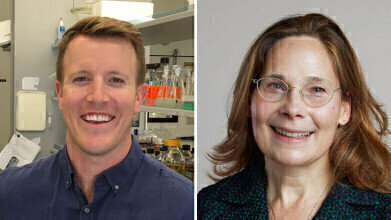-
 Sean Workman and Natalie Strynadka
Sean Workman and Natalie Strynadka
News & Views
Breaking Down Walls – Study highlights use of Existing Drugs
Jan 24 2022
Canadian scientists working to design enhanced versions of existing drugs to treat antimicrobial-resistant germs such as MRSA, have used the Canadian Light Source (CLS) at the University of Saskatchewan to image how these newer drugs interact with a molecule vital for building the cell wall of bacteria.
They focused on the protein UppS, a potentially attractive target as it is involved in assembling part of the lipid scaffold on which the thick protective wall of Staphylococcus aureus is built.
By slowing down the function of UppS we can make the bacteria more sensitive to other drugs,” said Sean Workman, a postdoctoral researcher in the Department of Biology at the University of Regina.
Eric Brown, a professor in the Department of Biochemistry and Biomedical Sciences at McMaster University, searched for drugs that could target the early steps in the creation of the cell wall and found clomiphene, an already-approved fertility drug that could interfere with UppS. He and his colleagues then used the same techniques to find several new molecules that could do the same thing, two of which – MAC-0547630 and JPD447 – seemed to be worth a closer look.
Workman, at the time a PhD student in Natalie Strynadka’s lab in the Department of Biochemistry and Molecular Biology at the University of British Columbia, then used the Canadian Macromolecular Crystallography Facility (CMCF) beamline at CLS to take detailed 3D pictures of how the three drugs interact with UppS, to see what might make one more effective than the others.
Uses X-ray light millions of times brighter than the sun, the beamline produced 3D structures of the molecule revealing how the drugs effectively clogged up the active site of UppS, a tunnel in the protein that the lipid normally grows into as it is being assembled, thus effectively blocking the lipid.
Workman also discovered why JPD447 is more effective than the almost identical MAC-0547630. The difference, which is just a single carbon atom, means JPD447 is able to reach out further and bind more tightly to a specific spot in the tunnel of the UppS protein.
The insights gained from the 3D structures could help scientists to design new versions of the drugs that are even more effective, in a process known as structure-guided drug design.
“We were able to figure out why one small change works better,” said Workman. “Hopefully that can lead to the development of even better drugs.”
Published in the Journal of Medicinal Chemistry
More information online
Digital Edition
ILM 49.5 July
July 2024
Chromatography Articles - Understanding PFAS: Analysis and Implications Mass Spectrometry & Spectroscopy Articles - MS detection of Alzheimer’s blood-based biomarkers LIMS - Essent...
View all digital editions
Events
Jul 28 2024 San Diego, CA USA
Jul 30 2024 Jakarta, Indonesia
Jul 31 2024 Chengdu, China
ACS National Meeting - Fall 2024
Aug 18 2024 Denver, CO, USA
Aug 25 2024 Copenhagen, Denmark

.jpg)

24_06.jpg)













